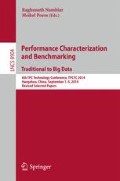Abstract
This study quantifies the tradeoff associated with alternative physical representations of a social graph for processing interactive social networking actions. We conduct this evaluation using a graph data store named Neo4j deployed in a client-server (REST) architecture using the BG benchmark. In addition to the average response time of a design, we quantify its SoAR defined as the highest observed throughput given the following service level agreement: 95 % of actions to observe a response time of 100 ms or faster. For an action such as computing the shortest distance between two members, we observe a tradeoff between speed and accuracy of the computed result. With this action, a relational data design provides a significantly faster response time than a graph design. The graph designs provide a higher SoAR than a relational one when the social graph includes large member profile images stored in the data store.
Access this chapter
Tax calculation will be finalised at checkout
Purchases are for personal use only
Notes
- 1.
SoAR is different than tps in that the SLA can be changed depending on the requirements of an application while TPC-C’s specified SLA is fixed.
- 2.
The size of these attributes is configurable [6].
- 3.
Cypher is a declarative language similar to SQL.
- 4.
They are termed Basic and Manual in [10] with a relational and JSON representation of BG social graph.
- 5.
The torus characteristics of the mod function guarantees \(\phi \) friends per member.
- 6.
BG is a stateful benchmark that generates valid actions only. When it invokes the AFR action involving Member A and \(U_r\), it does so based on its knowledge of \(U_r\) having a pending friend invitation from A. See [7] for details.
- 7.
Due to licensing agreement, we cannot disclose the identity of this system.
References
Amsden, Z., Bronson, N., Cabrera III, G., Chakka, P., Dimov, P., Ding, H., Ferris, J., Giardullo, A., Hoon, J., Kulkarni, S., Lawrence, N., Marchukov, M., Petrov, D., Puzar, L., Venkataramani, V.: TAO: how facebook serves the social graph. In: SIGMOD Conference (2012)
Angles, R., Boncz, P., Larriba-Pey, J., Fundulaki, I., Neumann, T., Erling, O., Neubauer, P., Martinez-Bazan, N., Kostev, V., Toma, I.: The Linked data benchmark council: a graph and RDF industrybenchmarking effort. SIGMOD Rec. 43, 27–31 (2014)
Angles, R., Prat-Pérez, A., Dominguez-Sal, D., Larriba-Pey, J.: Benchmarking database systems for social network applications. In: First International Workshop on Graph Data Management Experiences and Systems, GRADES 2013 (2013)
Armstrong, T., Ponnekanti, V., Borthakur, D., Callaghan, M.: LinkBench: a database benchmark based on the facebook social graph. In: ACM SIGMOD, June 2013
Bai, X., Junqueira, F.P, Silberstein, A.: Cache refreshing for online social news feeds. In: CIKM (2013)
Barahmand, S.: Benchmarking interactive social networking actions. Ph.D. thesis, Computer Science Department, USC (2014)
Barahmand, S., Ghandeharizadeh, S.: BG: a benchmark to evaluate interactive social networking actions. In: Proceedings of 2013 CIDR, January 2013
Barahmand, S., Ghandeharizadeh, S.: Benchmarking correctness of operations in big data applications. In: Proceedings of IEEE MASCOTS (2014)
Barahmand, S., Ghandeharizadeh, S.: Extensions of BG for testing and benchmarking alternative implementations of feed following. In: ACM SIGMOD Workshop on Reliable Data Services and Systems (RDSS), June 2014
Barahmand, S., Ghandeharizadeh, S., Yap, J.: A comparison of two physical data designs for interactive social networking actions. In: CIKM (2013)
Boncz, P.: LDBC: benchmark for graph and RDF data management. In: IDEAS, October 2013
Transaction Processing Performance Council. TPC Benchmarks. http://www.tpc.org/information/benchmarks.asp
Nishtala, R., et al.: Scaling memcache at Facebook. In: NSDI (2013)
Ghandeharizadeh, S., Barahmand, S.: A mid-flight synopsis of the BG social networking benchmark. In: Rabl, T., Raghunath, N., Poess, M., Bhandarkar, M., Jacobsen, H.-A., Baru, C. (eds.) WBDB 2013. LNCS, vol. 8585, pp. 19–31. Springer, Heidelberg (2013)
Gray, J.: The Benchmark Handbook for Database and Transaction Systems, 2nd edn. Morgan Kaufmann, San Mateo (1993). ISBN 1055860-292-5
Holzschuher, F., Peinl, R.: Performance of graph query languages: comparison of cypher, gremlin and native access in Neo4J. In: Proceedings of the Joint EDBT/ICDT 2013 Workshops, EDBT 2013 (2013)
Junqueira, F.P., Leroy, V., Serafini, M., Silberstein, A.: Shepherding social feed generation with sheep. In: SNS (2012)
Labouseur, A., Olsen, P., Hwang, J: Scalable and robust management of dynamic graph data. In: VLDB Workshop on Big Dynamic Distributed Data (2013)
Sears, R., Ingen, C.V., Gray, J.: To BLOB or not to BLOB: large object storage in a database or a filesystem. Technical report MSR-TR-2006-45, Microsoft Research (2006)
Silberstein, A., Machanavajjhala, A., Ramakrishnan, R.: Feed following: the big data challenge in social applications. In: DBSocial (2011)
Silberstein, A., Terrace, J., Cooper, B.F., Ramakrishnan, R.: Feeding frenzy: selectively materializing users’ event feeds. In: SIGMOD Conference (2010)
The Neo4j Team. The Neo4j Manual V2.1.1, 29 May 2014. http://www.neo4j.org
Tesoriero, C.: Getting Started with OrientDB. Packt Publishing Ltd, Birmingham (2013)
Author information
Authors and Affiliations
Corresponding author
Editor information
Editors and Affiliations
Rights and permissions
Copyright information
© 2015 Springer International Publishing Switzerland
About this paper
Cite this paper
Ghandeharizadeh, S., Boghrati, R., Barahmand, S. (2015). An Evaluation of Alternative Physical Graph Data Designs for Processing Interactive Social Networking Actions. In: Nambiar, R., Poess, M. (eds) Performance Characterization and Benchmarking. Traditional to Big Data. TPCTC 2014. Lecture Notes in Computer Science(), vol 8904. Springer, Cham. https://doi.org/10.1007/978-3-319-15350-6_2
Download citation
DOI: https://doi.org/10.1007/978-3-319-15350-6_2
Published:
Publisher Name: Springer, Cham
Print ISBN: 978-3-319-15349-0
Online ISBN: 978-3-319-15350-6
eBook Packages: Computer ScienceComputer Science (R0)

